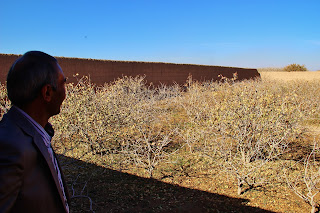12/07/2012
Drink! for you know not whence you came nor why: drink! for you know not why you go, nor where.
~ Omar Khayyam
Early in the morning Vahid, Baba, our Cousin, and I headed out for a day full of sightseeing.
 |
| Ready for the day to start! |
There is so much history in Iran! Nowhere in America can you head out the door and see sights like this:
 |
| Ancient ruins on the side of the road from Yazd to Meybod |
The next stop has an amazing story behind it. The legend goes that for many years the people living near this site had dreams of sand and mosques and no one could explain their dreams... until, one day, a man was out working his property after a storm and saw something protruding from the ground. After some inspection, he realized it was a building buried in the sand! The building was uncovered and found to be a mosque! This mosque was just uncovered in Mohammad's lifetime.

 |
| Baba-jan and his pistachio baq |
 |
| Me and the baq. There were even some foxes that scampered out ad we entered! |
Next, we visited an old shrine where Baba's father helped build the ceilings with his own hands! It is so much fun to see not only the history of Persia, but also the history of Mohammad's family.
We also visited an old water storage well called an Abanbar. I went to the bottom and ran some water. I was amazed, that not only does the Abanbar still provide water to the locals, but the water is so very pure and cold! The abanbars get their water from ancient qanats which were developed by the Persians in the first millenium B.C. Qanats were also connected to ancient Yakhchal, which produced ice in ancient days. The water from qanats were also used in ancient clocks (fenjaan) to tell time (read about fenjaan here http://en.wikipedia.org/wiki/Water_clock).
 |
| Abanbars are actualy quite deep into the ground |
 |
| at the bottom of the Abandar flowing the water for myself. |
The next stop was Madar Bazorg's house (Baba's mother's house) where Baba took me on a tour of the old house (the house is ancient and broken into two sections, one old and one new. The old section consists of a summer house and winter house). It was very fascinating. Later, we arrived at Agha's house for dinner and a small ceremony.
Eventually we parted ways and I went off with some of our cousins for the night. We did a little more sightseeing before heading to their home to sleep.
 |
The entrance hall leading to the door of the house that
Mohammad and his family lived in when he was born. |
 |
| another Abanbar |
 |
| Do they look similar??? |
 |
| A very old post office which has been turned into a postal museum |
 |
| Can't you just imagine what it was like to live here thousands of years ago? |
 |
| An ancient pigeon tower. The tower was closed, but our cousin told the guard I was visiting from America, and once again we were handed the keys to enter! Americans are definitely loved in Iran. |
 |
The ancient pigeon tower was made to attract pigeons to nest and poop
so that farmers could gather the droppings to use as fertilizer for their crops. |
 |
A VERY ancient castle in Meybod. Narin castle is estimated to be about 3000 years old
and contains possibly the oldest plumbing system in the world. |
 |
| Kids playing at a local park |
 |
| Oh how I miss the fresh bread! |











































Beautiful pictures. Is that the aab-anbar in Ardakan?
ReplyDelete